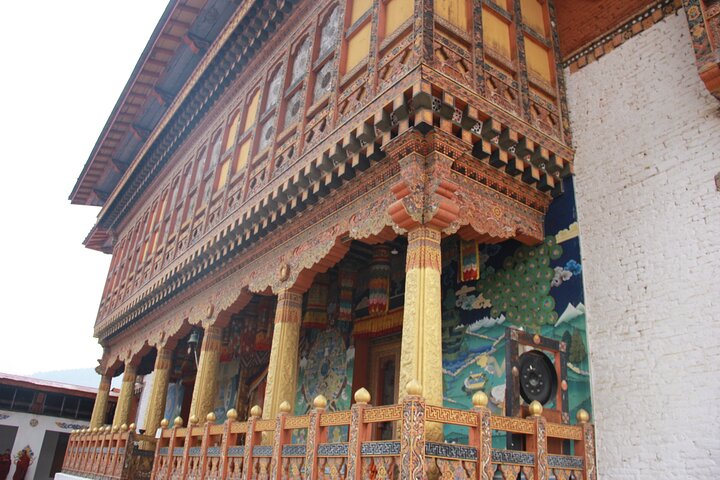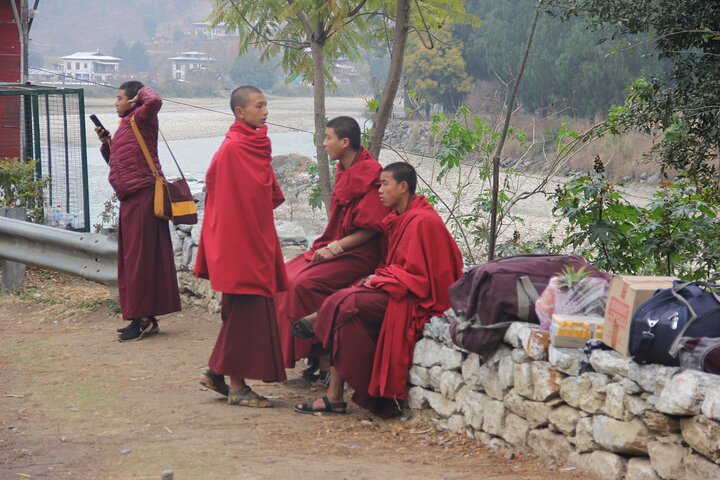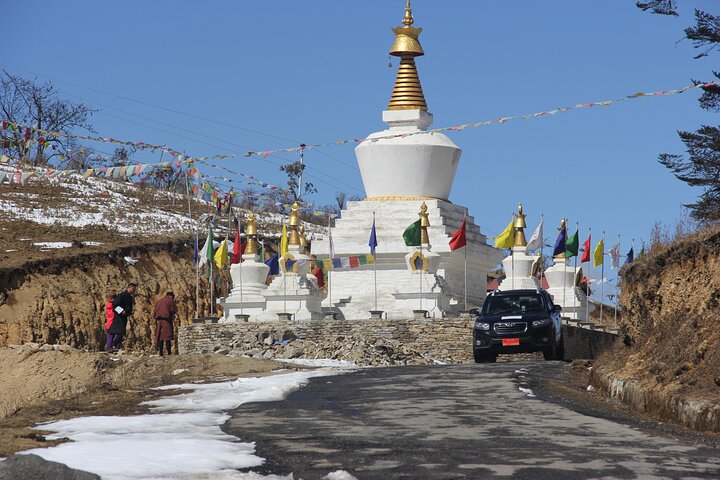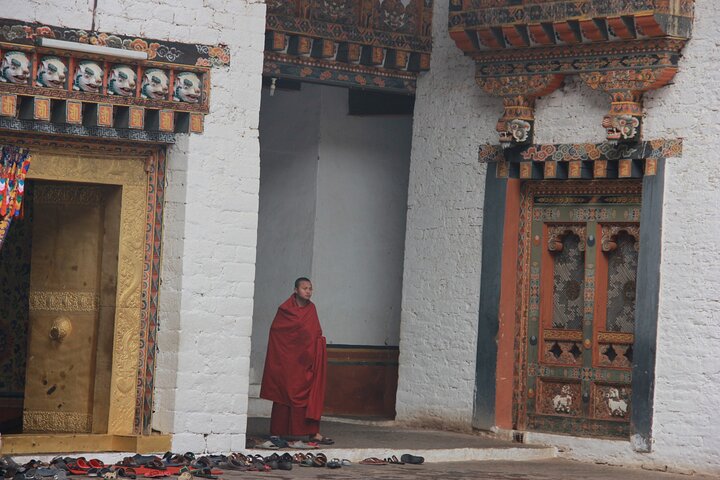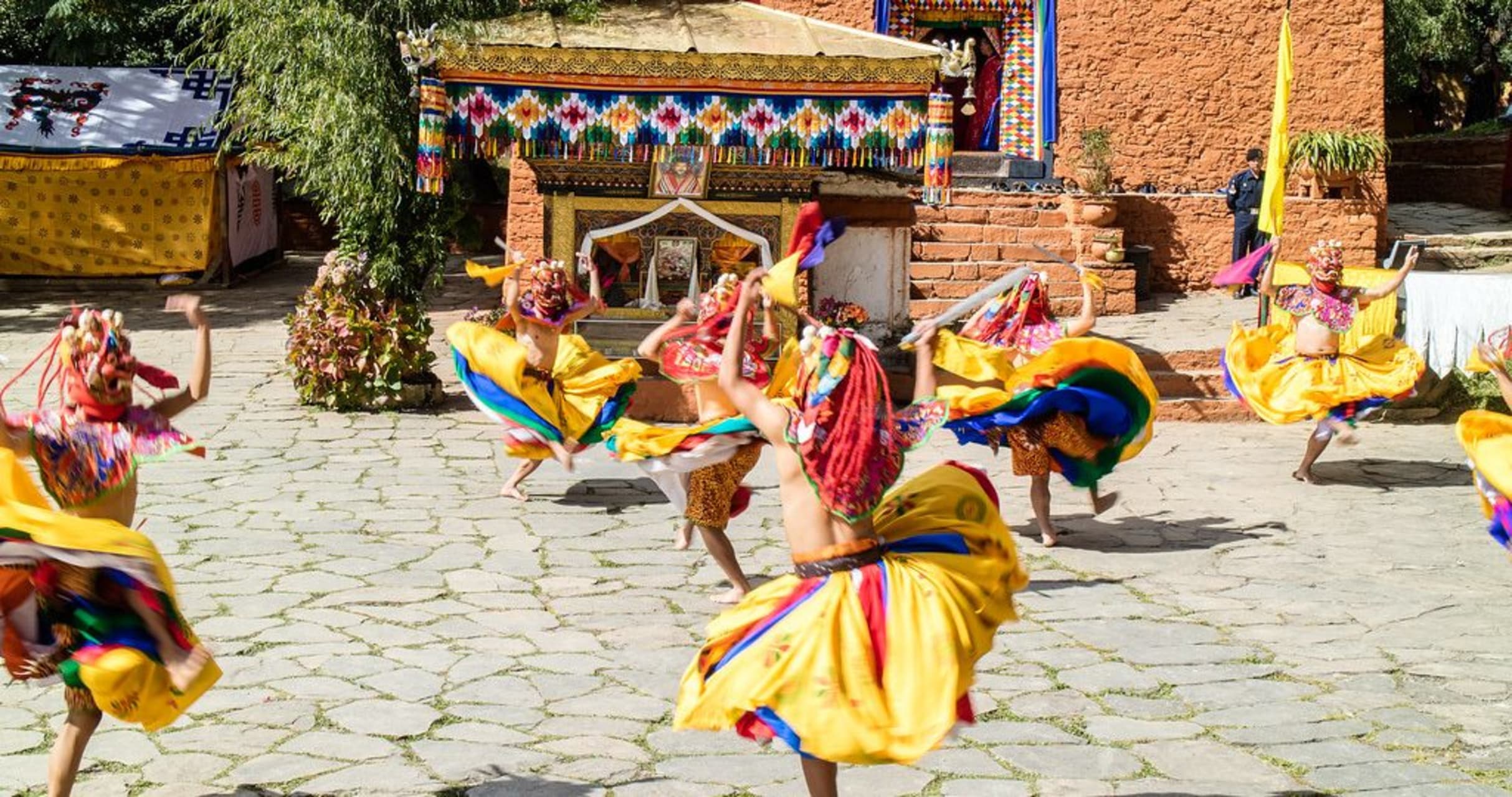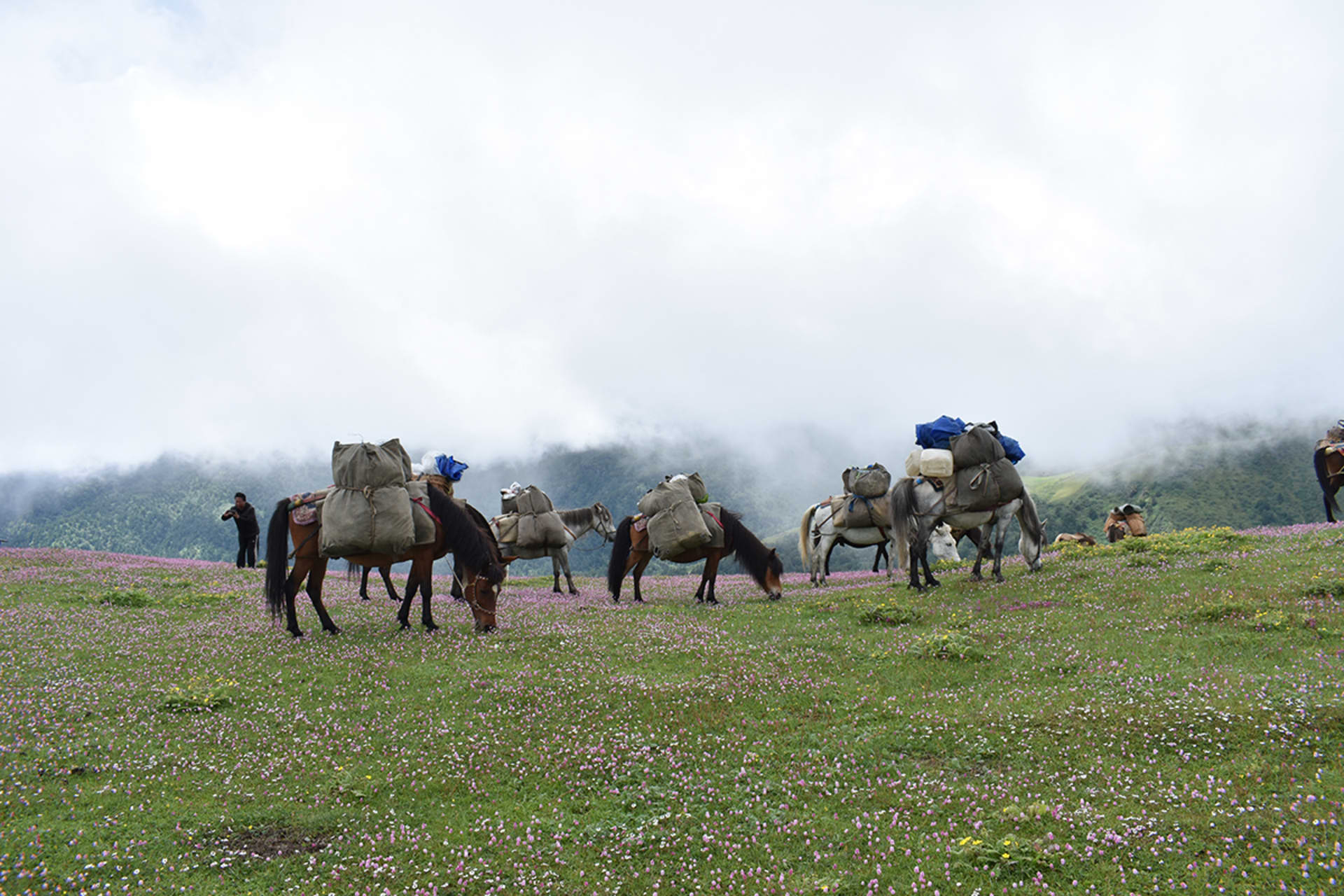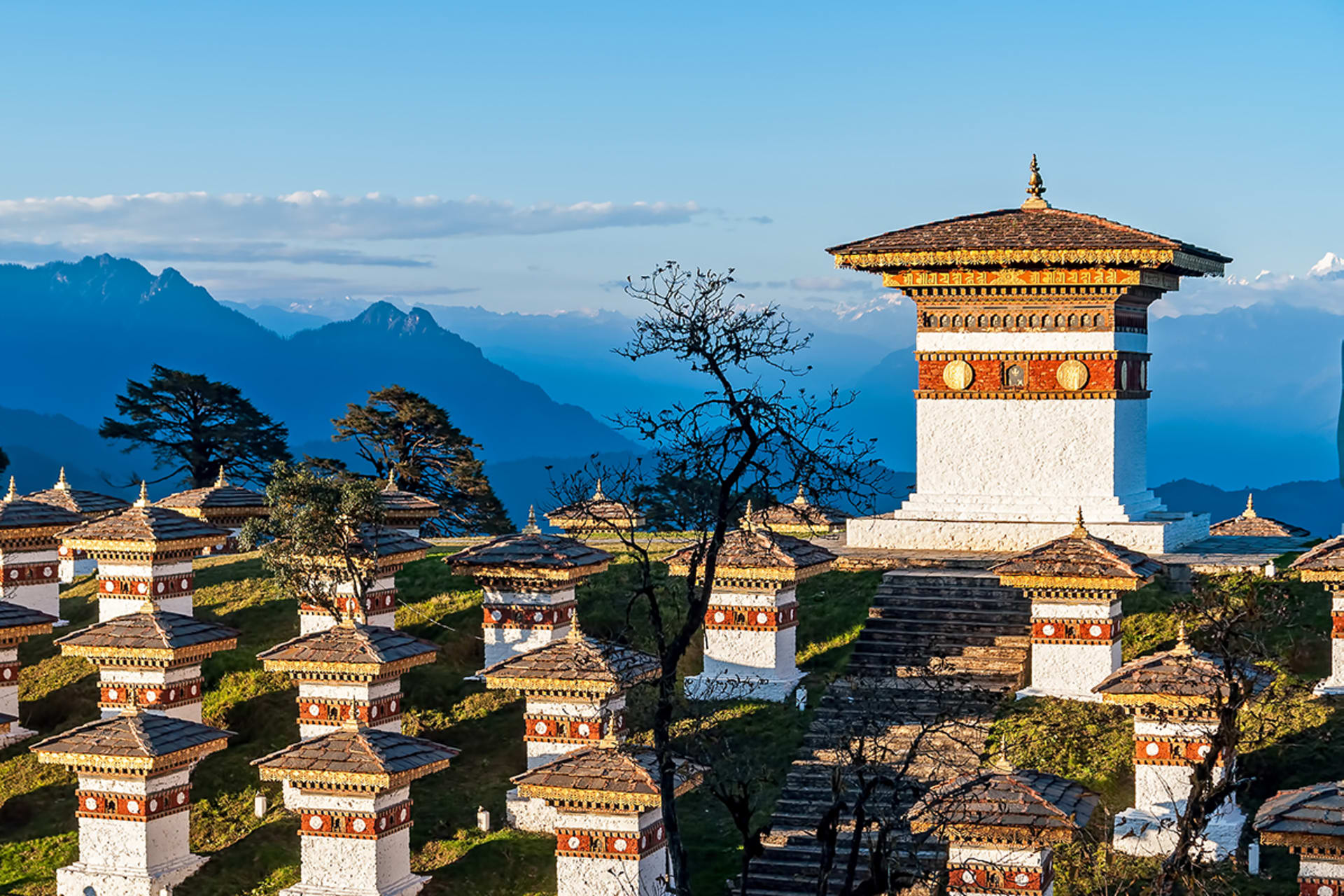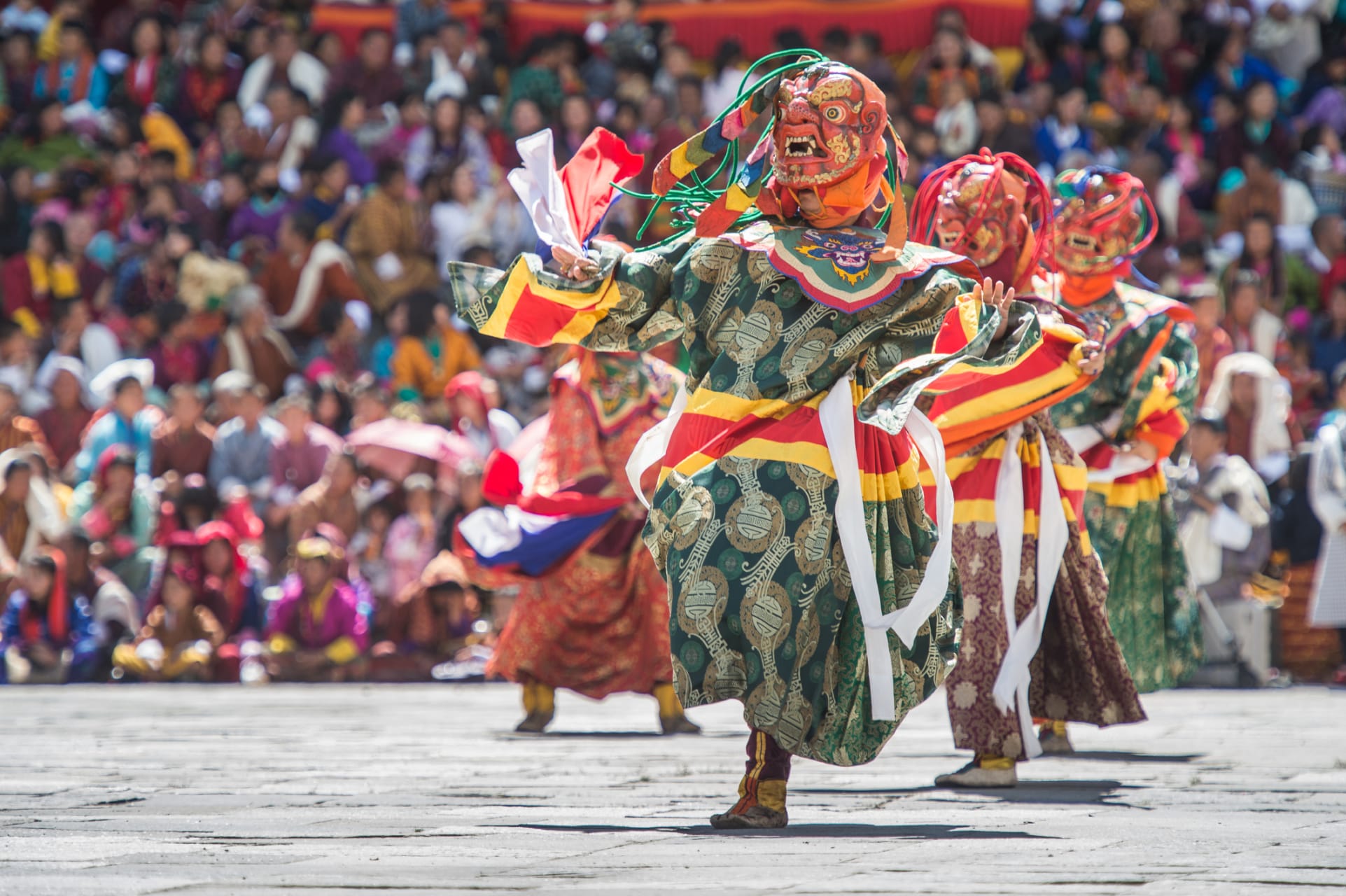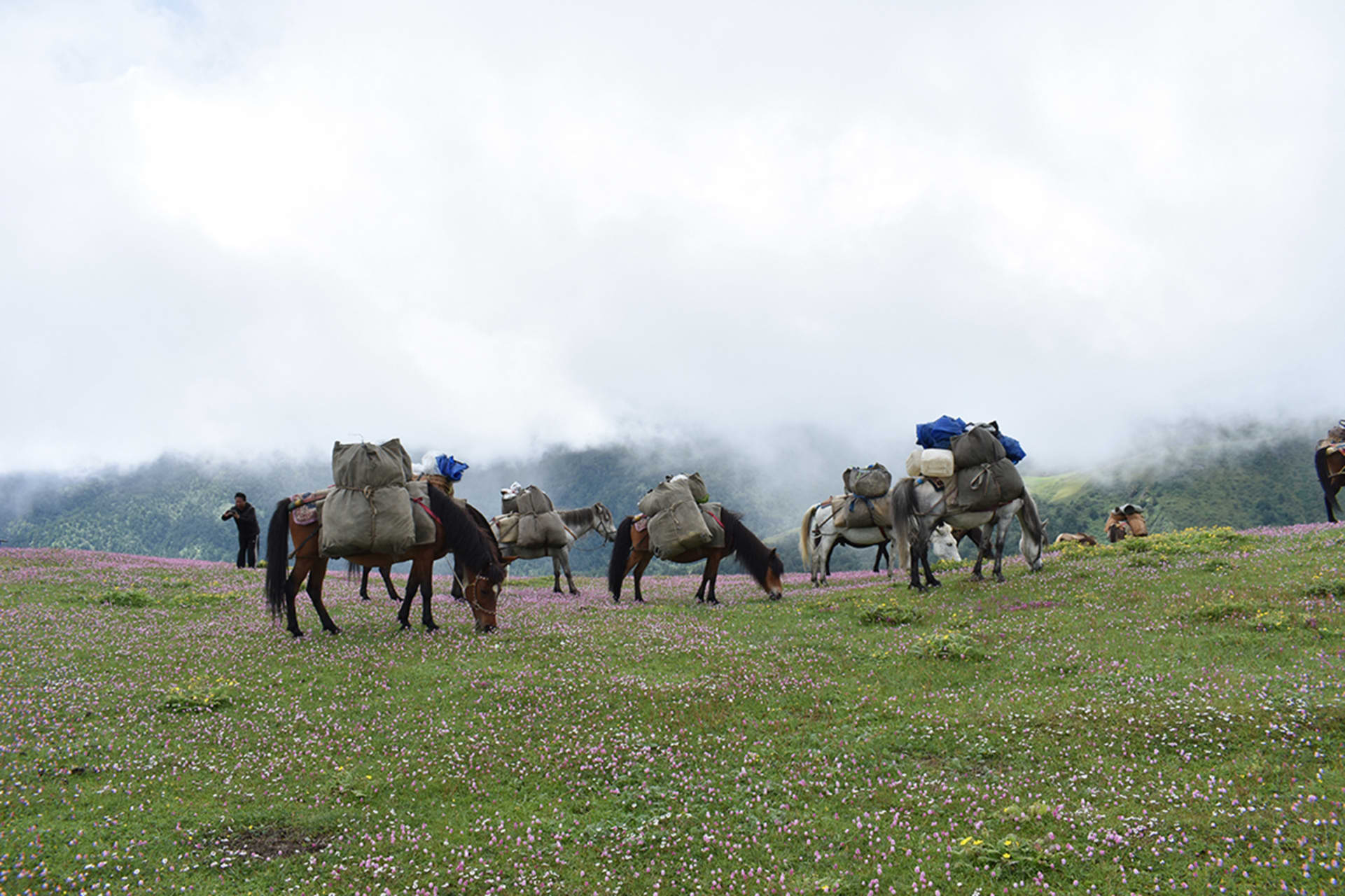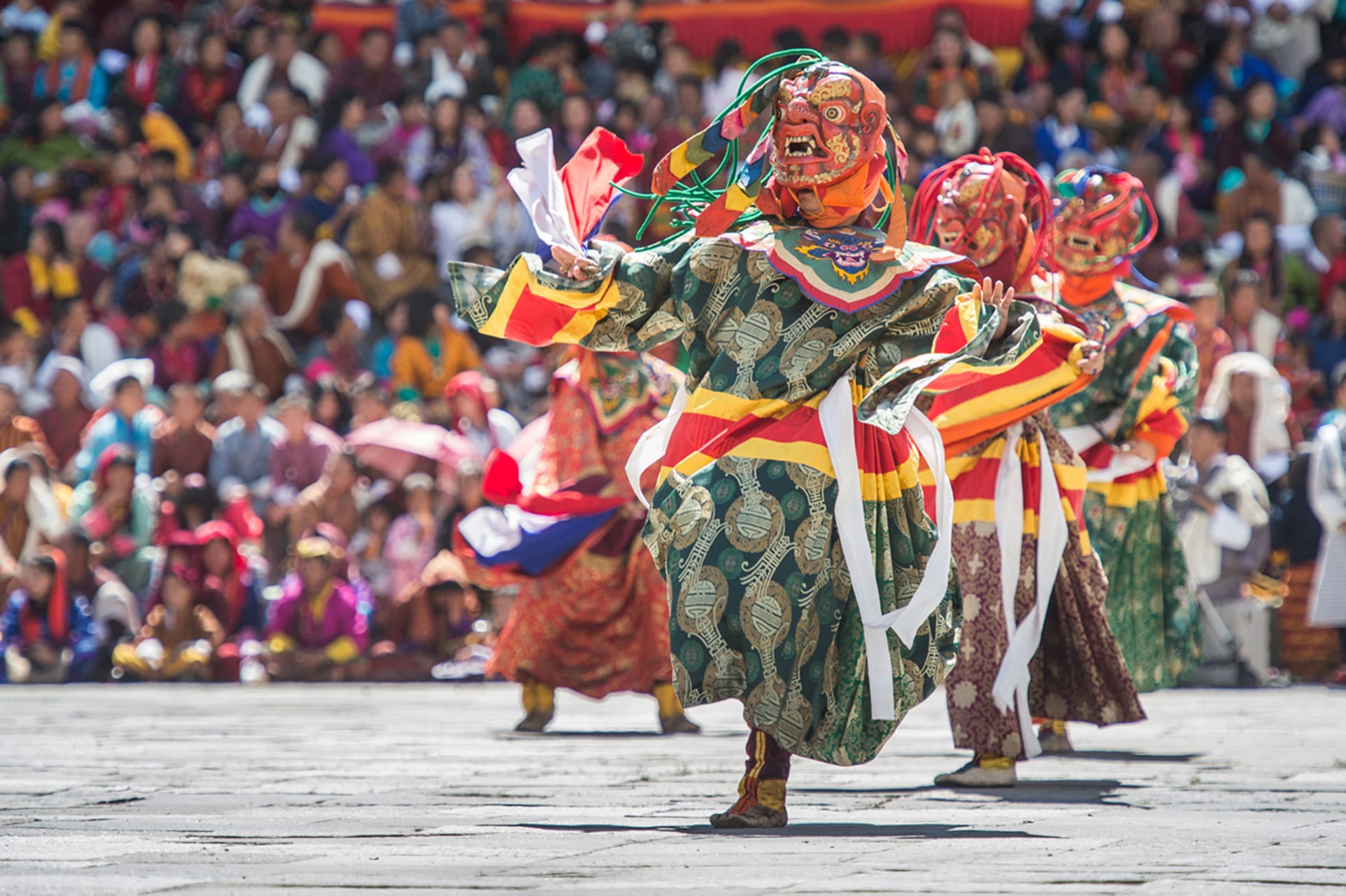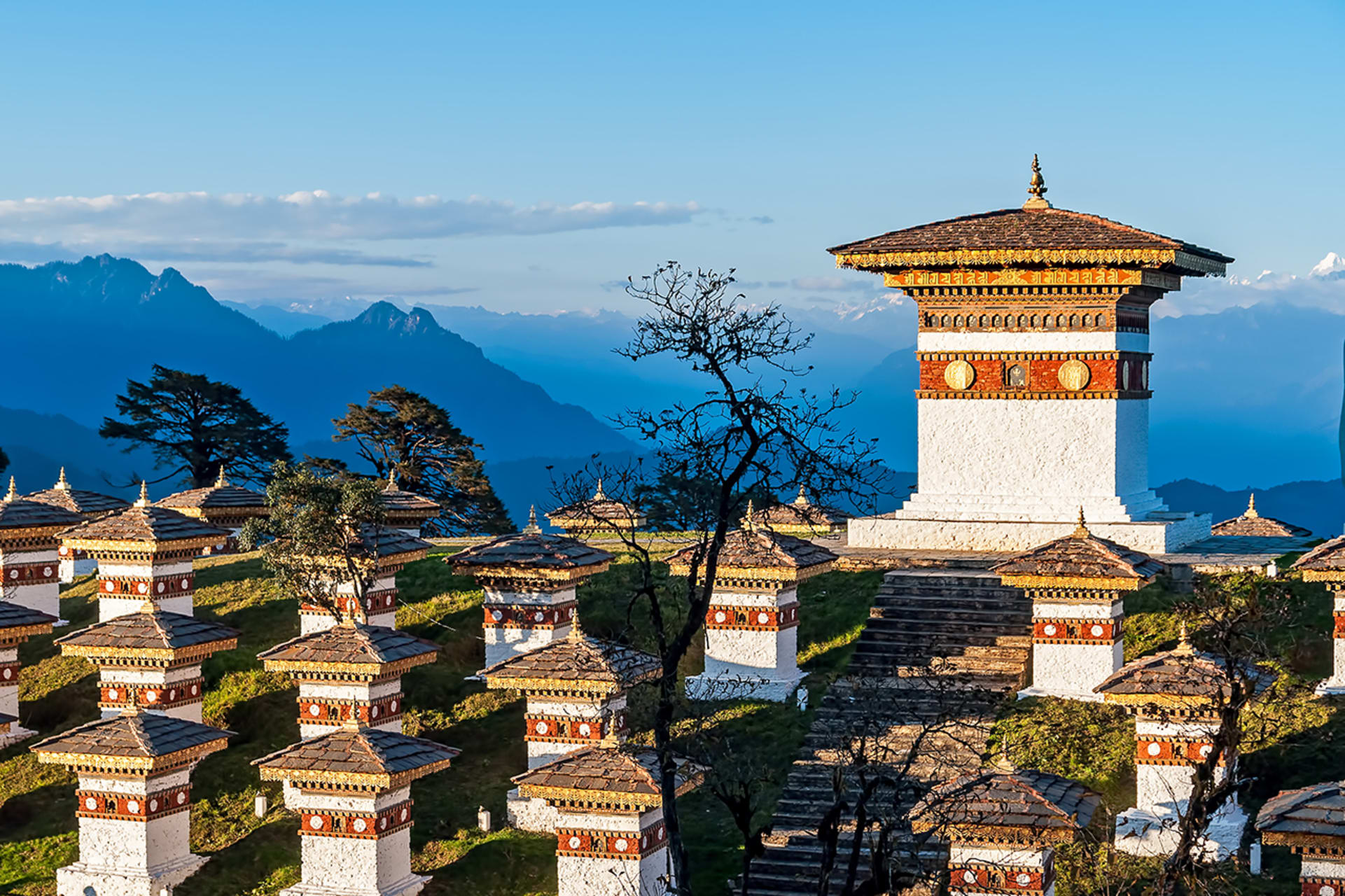It was never on anyone’s vacation wish list, and it just opened its doors to tourists a few years ago. Since then, Bhutan has miraculously become a hotspot for nature enthusiasts who come to experience the country’s rawness
The Last Shangri La
- Carbon-negative country, healthcare guarantee
- Trek in Himalayan Mountains, visit temples/monasteries
- Explore local destinations, Bhutanese cuisine, culture
- Local guides with years of experience
The Last Shangrila Bhutan Travel package offers a unique tour experience of the "Last Shangri-La" with local guides who have years of experience. The tour includes breakfast, private transportation, all fees and taxes, and bottled water, but lunch, alcoholic beverages, and the use of a bicycle are not included. You can explore local destinations, try out Bhutanese cuisine, experience the unique culture of the "Happiness People", visit temples and monasteries, and trek in the Himalayan Mountains. Bhutan is a great example of development achieved without sacrificing the environment and is the only carbon-negative country in the world. The package comes with a 24/7 healthcare and money-back guarantee, ensuring a relaxed Bhutan tour experience.
Day 01: Arrive at Paro
On a clear day, the journey to Paro is one of the most breathtaking of all mountain flights. Mt. Everest, Kanchenjunga, Makalu, and several peaks in Bhutan, including Chomolhari, Jichu Drake, and Tsering gang, can all be seen. The first gift you’ll receive from Bhutan will be cool, pure fresh air as you exit the plane. Upon arriving at Paro airport, our representative will greet you and transport you to your accommodation. Take a stroll through Paro’s market and town in the evening. In Paro, spend the night in a hotel.
Day 02: Paro
Paro is a lovely valley with tiny hamlets nestled among terraced paddy fields. The architecture and basic way of life in the town still maintain traditions. A morning visit to Ta Dzong, or the National Museum, one of Asia’s top natural history museums. Ta Dzong’s collections are one-of-a-kind and diverse, spanning from ancient armor to textiles, thangka paintings, and natural life. Then continue down the trail to Paro Dzong (Rinpung Dzong), which was established in 1646 under the reign of Shabdrung Ngawang Namgyal. It now serves as the site of the Paro monastic school and the civil administration’s office.
Rinpung Dzong is also the site of the Paro Tshechu, which takes place once a year in the spring. Drive up the valley in the afternoon to the Drukgyel Dzong, or Fort of Drukpa Victory. Bhutanese have repulsed Tibetan invasions from this fortification throughout history. The snow-capped top of Mt. Chomolhari looms over the smoldering wreckage. Traditional Bhutanese Farm House, tucked beneath the dzong, is a must-see. Then drive to Paro town, stopping along the way to see Kyichu Lhakhang, one of Bhutan’s oldest monasteries and a symbol of Buddhism’s introduction to the country. In Paro, stay at a hotel for dinner and the night.
Day 03: Paro – Thimphu (55 km, 2 hours)
After breakfast an excursion to Taktsang Monastery viewpoint. It is one of the most famous of Bhutan’s monasteries, perched on the side of a cliff 900 m above the Paro valley floor. It is said that Guru Rinpoche arrived here on the back of a tigress and meditated at this monastery hence it is called ‘Tiger’s Nest’.
Drive to Thimphu, Bhutan’s capital, through gorgeous countryside, villages, and paddy fields. Visit the Simtokha Dzong, one of the country’s oldest fortifications, which today serves as the home of the School for Religious and Cultural Studies. In Thimphu, spend the night in a hotel.
Day 04: Thimphu
A visit to the National Library, which houses a great collection of ancient Buddhist literature, manuscripts, modern academic publications, and printing blocks for prayer flags, is included in today’s full day of touring in Thimphu valley. Traditional thangka paintings are famous from this Arts & Crafts or Painting School. The Textile and Folk Heritage Museum is a wonderful showcase of Bhutanese material culture and living traditions. The exquisite Memorial Chorten was created in honor of Bhutan’s third King. The monument’s murals and statues provide a comprehensive insight into Buddhist philosophy.
Tashichhodzong is a magnificent fortress/monastery that contains the Secretariat, the King’s Throne Room, and various government offices. The Handicrafts Emporium, which shows a broad variety of wonderfully hand-woven and produced handicrafts, is also the summer house of Chief Abbot. In Thimphu, spend the night in a hotel.
Day 05: Thimphu – Punakha (75 km, 3 hours)
Morning tour of the local market and town in Thimphu. Then cross the Dochula and pass on your way to Punakha (3, O8Om). A big Bhutanese Chorten and prayer flag mark the passes in Bhutan. On a clear day, Dochula pass provides the most stunning vista of the eastern Himalayas’ high peaks. Check into the hotel when you arrive at Punakha. Punakha was the capital of Bhutan until 1955, and it is now the winter residence of Je Khenpo, Chief Abbot. Punakha Dzong was erected in the 17th century by Zhabdrung Ngawang Namgyal and is located at the confluence of the Pho Chu and Mo Chu rivers. In Punakha, spend the night in a hotel.
Day 06: Punakha – Wangduephodrang -Gangtey (Phobjikha) (70 km, 3 hours)
Drive to Wangduephodrang after breakfast and see the Dzong, which is located on a spur at the junction of two rivers. Dzong’s location is exceptional because it totally covers the spur and boasts a commanding view of both the north-south and east-west directions. Wangdue is also known for its bamboo handicrafts, slate carving, and stone carving. The road to Phobjikha Valley passes through an oak and rhododendron woodland. Phobjikha is one of Bhutan’s few glacial valleys and the preferred home of black-necked cranes migrating from the Central Asian Plateau to avoid the hard winters. Explore the Phobjikha Valley and pay a visit to Gangtey Monastery, Western Bhutan’s sole Nyingmapa monastery. Overnight stay in a guest house or a camp.
Day 07: Gangtey (Phobjikha) – Trongsa (128 km, 4.1/2 hours)
Morning explores Phobjikha valley for Black Neck Cranes and later drives to Trongsa across Pelela pass (3,300m) (3,300m). This pass has long been regarded as the dividing line between western and central Bhutan. Stop along the route at Chendebji Chorten, a Nepalese-style temple built in the 18th century. The scenery around Trongsa is breathtaking, and the dzong seems to tease you for miles, making you wonder whether you’ll ever get there. Check into the lodge as you arrive. In Trongsa, stay in the lodge for dinner and the night.
Day 08: Trongsa – Bumthang (Jakar) (68 km, 3 hours)
Morning tour to Trongsa Dzong, which is located at the top of the mountain. It is Bhutan’s most spectacular dzong, standing at 2,200 meters and was erected by the Shabdrung in 1647. Then go to the Ta Dzong, which was erected to protect Trongsa and stands on the edge of a mountain. After lunch, travel to Bumthang, one of Bhutan’s most beautiful valleys and the spiritual heartland of Buddhism. Cross Yutong La pass (3,400m) 29 kilometers ahead of Trongsa, and the environment changes again, with deep coniferous forests stretching for miles. Bumthang’s arrival is marked by the broad, manicured Chumey valley. In Bumthang, spend the night at the lodge.
Day 09: Bumthang
Bumthang refers to a group of four valleys — Chumey, Choekhor, Tang, and Ura – with elevations ranging from 2,600 to 4,000 meters. Visit to Kurje Lhakhang, one of Bhutan’s holiest sites, where Guru Rinpoche meditated. A tarmac road leads south from Kurje monastery along the right bank of the river to the Jambay Lhakhang. This temple, like Kyichu Lhakhang in the Paro valley, is considered to be the first built by King Songtsen Gampo of Tibet in the 7th century. Afternoon visit Pema Lingpa’s Tamshing Lhakhang, which he founded in 1501. It houses some fascinating Buddhist paintings from the past. Later, see the Jakar Dzong, or “White Bird Dzong.” Take a stroll through the Bumthang market district in the evening. In Bumthang, stay at the lodge for dinner and the night.
Day 10: Bumthang – Mongar (198 km, 7 hours)
The route continues eastward, weaving through more challenging terrain. The 7-hour drive will take you through breathtaking scenery. Pass past Bumthang’s Ura village before climbing steeply to the Kingdom’s highest motorable pass, the Thrumshingla pass (4000m). As you descend to Sengor, keep an eye out for cascading waterfalls. At 700 meters, the fall comes to a halt on a bridge across the Kurichu. Return to Mongar town via pine forests, maize fields, and eastern hamlets. Visit Mongar Dzong, which, despite its recent construction, follows the architectural traditions of historic dzongs. In Mongar, spend the night in the lodge.
Day 11: Mongar – Trashigang (96 km, 3 hours)
Day 12: Trashigang (excursion to Trashiyangtse)
Visit the Gom Kora temple, located 24 kilometers from Trashigang on a small alluvial plateau overlooking the river. Guru Rinpoche is said to have defeated a monster at Gom Kora. Further on, you’ll come to Doksum village, where you’ll observe ladies weaving traditional Bhutanese fabric and a 15th-century chain bridge. Visit Trashiyangtse Dzong, which is located at an elevation of 1,850 meters. Trashiyangtse was once a major center due to its location on one of the caravan routes connecting western and central Bhutan. The dzong is brand new, and the Art school and the famed chorten Kora are both nearby. Return to Trashigang in the evening. In Trashigang, stay at the lodge for dinner and the night.
Day 13: Trashigang – Samdrup Jongkhar (180 km, 6 hours)
The Trashigang – Samdrup Jongkhar road was finished in 1965 and takes about 6 hours to travel. Pass past Sherubtse College, the country’s lone college, which was created in 1978. Visit the Zangtho Pelri shrine, which the late Minister of Home Affairs established in 1978. Guru Rinpoche’s utopia is represented by it. Continue on to Khaling to see the Blind School and the Weaving Centre. Deothang, 80 kilometers east of Khaling, is the home of the Technical Training College and the East’s road maintenance headquarters. The road drops quickly to the plain from here, passing through a deep tropical forest with plenty of teak, bamboo, and ferns. In Samdrup Jongkhar, spend the night at the lodge.
Day 14 : Depart Samdrup Jongkhar
After breakfast, transfer to the Bhutan border, where you will be met by an Indian agent and taken to your next destination.
- Visit to most sacred temples and monastery in Bhutan
- Exclusive Bhutanese village visits
- Experience firsthand Bhutanese lifestyles
- Trek in Himalayan Mountains
- Bar Bills
- Laundry Bills
- Tips and gratuity to Guides and hotel staffs
Start Location: Paro International Airport, Paro, Bhutan
- Wheelchair accessible
- Stroller Accessible
- Service animals allowed
- Infant seats available
- Parking available close by
Guide : English, Spanish, French, German, Italian, Czech, Dutch, Japanese, Korean, Hindi
- Bhutan: paradise for nature lovers, committed to eco-preservation.
- Paro journey: breathtaking mountain flight, views of Mt. Everest.
- Bhutan has ancient fortresses, monasteries & rich cultural history.
- Former Bhutan capital Punakha, now winter residence of Chief Abbot & home to Punakha Dzong.
- Bhutan, the Shangri-la, is a raw nature hotspot. Perfect for enthusiasts.
- Bhutan emits zero carbon, a unique feat globally.
- Explore Taktsang Monastery, Bhutan's famous cliff-side temple 900m above Paro valley floor.
Cancellation Cutoff: 24 days
Cancellation Notes: Up to 24 hours before the beginning of the activity: full refund Less than 24 hours before the beginning of the activity or no-show: no refund
| The Last Shangri La | RETAIL PRICE |
|---|---|
| adult (18 - 120 years) | $450.00 |
| Child (5 - 11 years) | N/A |
- Kyichu Lhakhang སྐྱིད་ཆུ་ལྷ་ཁང་།, Bhutan
- Punakha Dzong སྤུ་ན་ཁ་རྫོང་།, Bhutan
- Taktsang Palphug, Taktsang Trail, Paro, Bhutan
- Taa Dzong Parking, Paro, Bhutan
- Phajoding Monastery ཕ་ཇོ་ལྡིང་།, Phajoding-Pumola Trail, Phajoding, Bhutan
- National Memorial Chhorten རྒྱལ་ཡོངས་རྗེས་དྲན་མཆོད་རྟེན།, Chhoten Lam, Thimphu, Bhutan
- National Institute for Zorig Chusum, Thimphu, Bhutan
- Tashichho Dzong, Thimphu, Bhutan
- Buddha Dordenma Statue སྟོན་པ་རྡོར་གདན་མ།, Thimphu, Bhutan
- Dumgtseg Lhakhang, Paro, Bhutan
- Chimi Lhakhang, Teoprongchu, Bhutan
- Khamsum Yulley Namgyal Choeten, Thimphu-Punakha Hwy, Bhutan
- Cheri Goempa, Norzin Lam 2, Thimphu, Bhutan
- Rinpung Dzong རིན་སྤུང་རྫོང་།, Paro, Bhutan
- Royal Takin Preserve, Bhutan
- Bhutan, Dzongdrakha Monastry
- Tango Buddhist College, Bhutan
- Changangkha Lhakhang ལྕང་སྒང་ཁ་ལྷ་ཁང་།, Changangkha Lhakhang Footpath, Thimphu, Bhutan
- Dochula Chorten, Trashigang-Semtokha Highway, Hungtso, Bhutan
The conditions of Truly Bhutan, Bhutan, apply.
Our Company Email
Truly Bhutan website
+97577111115
Company Address & Location:
Taba Wom-6,
Kinley Penjor Building,
Flat No | 08
Taba, ThimThrom,
Thimphu Bhutan | 11001
SPECIAL TERMS & CONDITIONS
Addendum to General travel terms & conditions (ARB 1992)
Preface
We want to advise that there are no particular dangers of trekking in Bhutan except the snowman trek, which is for over 20 days at an altitude of over 4000 meters. It is one of the toughest treks in the world. High altitudes there can occur with certain difficulties in connection with adapting to the elevation. Your body has to adapt–the altitude, the temperature, and the unusual physical effort put a strain on your circuit. Some trips might have very remote destinations, so there can be a few hours of delays if you need help from outside the area after an accident other than that it’s safe to trek in Bhutan. These Special terms & conditions on hand are effective besides the General travel terms & conditions (ARB 1992). In case of contradiction, the BRB applies primarily, the ARB 1992 secondary.
Our Concern
We want to promote fair tourism with a positive effect on the locals. We have local guides accompanying you on your journeys as and when required.; they serve as people go between the cultures and facilitate good communication with the locals.
Registration and Payment
Registration takes place in written form via email. The travel contract is concluded if we mutually agreed on all the conditions of the contract (prices, services, and date in written acknowledgment). After you receive your travel confirmation, full payment of the travel price is due.
When we act as agents, please refer to the terms of payment of the respective operator (e.g. the airline). Payment by credit card is possible with a surcharge of 4% of the amount due.
Cancellation Rules
Until 60 days before commencement of travel: 40%;
59th-30th day: 70%;
29th-20th day: 90%;
From the 19th day or when interrupting a trip or you cannot appear at departure,
100%; of the tour cost.
For cancellations of flight bookings, we will charge cancellation fees as per the airline’s policy and add a handling fee of $100/.
Personal Responsibility/State of Health
Participation in our trips happens at your own risk, being aware of all the particular dangers. Our clients follow all the rules for passport, visa, foreign exchange, customs, and airport and health regulations regardless of our duty to supply information. We advise you to consult your doctor in case of preexisting conditions and an unstable state of health before your trip. Every participant handles the assessment of his or her fitness level and physical shape. We will inform you about the fitness requirements for every trip. We want to specifically point out that in case of travel interruption; It does not entitle you to a refund of payments already made.
Adventure Aspect
Trekking-, expedition or hiking trips are “Risk travels” as defined by the General travel terms & conditions. The character of a trekking-, expedition- or hiking trip can–under certain circumstances–demand changes from the original plan (weather, conditions of roads and paths, official arbitrariness, technical failures/defects, etc.) This particularly concerns transport (changes in flight plans, temporary lack of transportation, vehicle defects, animal illness, etc.). Therefore, if there are any delays, limitations, or cancellation of parts of the program for one of those reasons, the contracting parties expect we do not see the possibility of those incidents as a defect. No warranty claims can be requested for that reason. We guarantee meticulous planning and careful arranging of our tours. The tour operator is liable for any personal or property damage resulting from a fault on our part–occurring, despite the aforementioned principles.
There is only one exception: we are not liable for property damage because of ordinary negligence–this also includes external service. If there are limitations to the damage claims or if claims are not possible to file at one of our service providers (through international agreements), there are the same regulations apply to our services. We are not liable for damages that happen because our tour guide’s instructions were not followed! It is an obligation to follow the instructions of our tour guides (concerning performance during the tour and the safety of the participants).
It is an important part of your travel contract. If someone is culpably transgressing his or her contractual obligation, he or she has to make good any damages occurring to the tour operator. If an accompanying traveler cannot attend, we will provide a substitute companion–this is not a reason to cancel the tour (at our cost). Means of transport are not luxury vehicles, the conditions on the road are sometimes rough, so our equipment is functional, not luxurious. There is no liability for damages to luggage.
Acts of nature beyond control
There is no influence on unforeseen circumstances like acts of nature, political unrest, etc.–resulting changes of the itinerary are possible, but no warranty claims can be requested for that reason. If those incidents result in higher/additional costs, we agree that the price of travel will be raised accordingly. Also at the expense of the travel participant: additional costs because of acts of nature, official order, or other reasons beyond our control (e.g. additional costs for airfare, accommodation, hotel, or transfer). We can isolate their cases where an overnight stay in a shared room is necessary (instead of the double/single room agreed upon), no warranty claims can be requested for that reason.
8. Route changes or adjustments
We want to point out that we are not selling “off-the-shelf” tours, and changes to the itinerary can occur because of various reasons. It shall be understood that all our services can be subject to change because of changes or diversions of the routes for just cause (e.g. worsening of weather, a change in the conditions of roads or paths, unforeseen weakness or illness of tour participant, important repair of vehicles, official arbitrariness, etc.)–no warranty claims can be requested for that reason. It is not a part of the travel contract that you reach a certain destination on your tour.
Specifications of hiking times
Our estimations of the character of a tour are always going to be average. The actual time walked is a sum of the hiking speed and local conditions. There is always room for variation–in one or the other direction. We can derive no legal claim from different hiking times.
Travel Insurance
We do not include travel insurance in our prices, but we strongly advise buying travel insurance. Especially for hiking-, expedition- and trekking tours.
Operator/Jurisdiction
Our Company Email
Truly Bhutan website
+97577111115
Address
Taba Wom-6,
Kinley Penjor Building,
Flat No | 08
Taba, ThimThrom,
Thimphu Bhutan | 11001
Bank details:
On legal grounds, we have to contrast our Special Terms & Conditions (BRB) with the General Travel Terms & Conditions (ARB) for your information.
THE TRAVEL AGENCY AS AN INTERMEDIARY
The following terms and conditions are the basis of the contract (customer ship agreement), which customers conclude with an intermediary.
Booking/conclusion of the contract
The booking can be made in writing or (remotely) orally. (Tele-) verbal bookings should be confirmed immediately in writing by the travel agency.
Travel agencies should use booking vouchers that contain all essential information about the client’s order, regarding the travel advertisement (catalog, brochure, etc.) on which the booking is based.
Regarding his performance and performance the organizer mediated by him, the intermediary shall, under § 6 of the Practice Regulations for the Travel Agency trade, apply to the actual.
GENERAL TERMS AND CONDITIONS OF TRAVEL,
draw attention to demonstrably deviating travel conditions and, in this case, hand them over before the conclusion of the contract.
Where services of foreign entrepreneurs (service providers, tour operators) are mediated, foreign law may also apply.
The person who makes a booking for himself or a third party is therefore considered to be the principal and, in the absence of any other declaration, assumes the obligations arising from the placing of the order vis-à-vis the travel agency (payments, withdrawal from the contract, etc.).
At the time of booking, the travel agent may charge a processing fee and a (minimum) deposit.
The last payment and the replacement of cash expenses (telephone charges, telex charges, etc.) are due when the travel documents (not including personal documents) of the respective tour operator or service provider are handed over to the travel agency.
Travel companies that accept bookings must provide the traveler with a confirmation of the travel contract (travel confirmation) at or without delay after the contract.
Information and other ancillary services
2.1. Information on passport, visa, currency, customs, and health regulations.
We assume known that a valid passport is usually required for travel abroad.
The travel agency shall inform the customer about the applicable foreign passports, visas, and health-policy entry regulations and about foreign currency and customs regulations upon request, where they can be found in Bhutan. In addition, the customer handles compliance with these regulations. If possible, the travel agency will provide information on special regulations for foreigners, stateless persons, and holders of dual citizenship.
2.2. Information about the travel service.
The travel agency must present to the best of its knowledge the service to be mediated by the tour operator or service provider, considering the particularities of the respective contract mediated and the circumstances of the respective destination country or destination.
Legal Status and Liability
The liability of the travel agency shall extend to:
The careful selection of the respective organizer or service provider and the careful evaluation of the experience gained;
The proper provision of services, including appropriate information for the customer and follow-up of travel documents;
The demonstrable transmission of announcements, declarations of intent, and payments between the client and the mediated company and vice versa (such as changes to the agreed service and the agreed price, declarations of withdrawal complaints).
The travel agency shall not be liable for the provision of the services provided or bought by it.
The tour operator shall provide the customer with the travel confirmation with the company word (product name), the address of the tour operator, and, if applicable, of an insurer under one, unless this information is already contained in the brochure, catalog, or other detailed promotional material. If it cannot do so, it is liable to the customer as an organizer or service provider.
Performance disruptions
If the travel agency breaches its obligations under the contractual relationship, it must compensate the customer for the resulting damage, if it does not prove that it is not guilty of willful intent or gross negligence.
For breach of contract because of lesser negligence, the travel agency must compensate the customer for any resulting damage up to the amount of the commission of the brokered transaction.
THE TRAVEL AGENCY AS ORGANIZER
The following conditions are the basis of the contract–the travel contract–in which the booking party concludes with an organizer either directly or with the help of an intermediary. In the event of a direct conclusion, the organizer shall fulfill the obligations of intermediaries accordingly.
The organizer recognizes in principle the present GENERAL TERMS AND CONDITIONS,
We show deviations in all its detailed advertising documents under § 6 of the Exercise Regulations.
Booking/Conclusion of contract
We conclude the travel contract between the booking party and the organizer if there is agreement on the essential elements of the contract (price, service, and date). This gives rise to rights and obligations for the customer.
Change in the person of the traveler
A change in the traveler’s person is possible if the replacement person fulfills all we can do the conditions for participation and in two ways.
2.1. Assignment of entitlement to travel services.
The obligations of the booking party under the travel contract remain valid if he assigns all or individual claims under this contract to a third party. Here, the booking party shall bear the resulting additional costs.
2.2. Transmission of the travel event.
If it prevents the customer from starting the travel event, they may transfer the contractual relationship to another person. It must communicate the transfer to the organizer either directly or through the intermediary within a reasonable period before the departure date. The tour operator may announce a specific deadline in advance. The transferor and the transferee shall be jointly liable for any unpaid remuneration and, where appropriate, for any additional costs incurred because of the transfer.
Contract content, information, and other ancillary services
Besides the information obligations incumbent on the intermediary (i.e. information on passports, visas, foreign currency, customs, and sanitary entry regulations), the organizer must provide sufficient information on his/her services. The service descriptions in the catalog or brochure are valid at the time of booking and the other information contained is the subject of the travel contract unless otherwise agreed upon at the time of booking. However, it is also recommended that such agreements should be in writing.
Travel with special risks
With journeys with special risks (e.g. expedition character), the organizer is not liable for the consequences that arise in the occurrence course of the risks, if this occurs outside its area of responsibility.
This does not affect the tour operator’s obligation to prepare the trip carefully and to handpick the persons and companies responsible for the provision of the individual travel services.
Legal bases in the event of disruptions in performance
5.1. Warranty.
The customer has a warranty claim in the event of non-performance or defective performance.
The customer agrees the organizer shall provide him/her with a fault-free service or improve the defective service instead of his/her right to conversion or price reduction within a reasonable period.
It may make remedies in how the defect is rectified or substitute service of equal or higher value, which also receives the express consent of the customer, is provided.
5.2. Compensation
If the organizer or his/her assistants culpably violate the obligations incumbent on the organizer from the contractual relationship, the latter shall be obliged to compensate the customer for the resulting damage.
Where the tour operator is liable for persons other than its employees, it shall be liable–except in cases of personal injury–only if it cannot prove that they were not willful or grossly negligent.
Except with willful intent and gross negligence, the tour operator shall not be liable for items not normally taken with him/her unless he/she has taken them into custody with knowledge of the circumstances.
We, therefore, recommended that the customer does not take any items of special value with him. We also recommended that we properly stored the items taken with you.
5.3. Notification of defects.
The Customer shall immediately notify a representative of the Organizer of any defect in the contract’s performance that he discovers during the trip. This presupposes that one has been made known to it can reach him and that he is on the spot with no significant effort. Omitting this communication does not alter point 5.1. Described warranty claims of the customer. However, it may be imputed to him as a co-fault and, to this extent, reduce any compensation claims. However, the organizer must have informed the customer in writing, either directly or through the intermediary, of this obligation to notify. Likewise, the customer must have been informed at the same time that failure to communicate does not affect his warranty claims, but can be credited as a co-fault. In the absence of a local representative, it is advisable to inform either the respective service provider (e.g. hotel, airline) or directly the organizer of any deficiencies and to request remedial action.
5.4 Assertion of any claims
To facilitate the assertion of claims, we recommend the customer get written confirmation of non-provision or defective provision of services or secure documents, proofs, and witnesses.
We can only assert warranty claims within 6 months. For bookings from 23rd September 2022 onwards, 100 days deadline applies to consumers.
Claims for damages expire after 1 year
It is advisable in the traveler’s interest to make claims immediately after returning from the trip directly with the organizer or through the intermediary travel agency, as with increasing delay there are likely to be difficulties of proof.
Cancellation of the contract
7.1. Cancellation by the customer before the start of the trip.
Cancellation without a cancellation fee
Apart from the statutory right of withdrawal, the Customer may withdraw
without the organizer having any claims against them in the following cases,
which occur before the beginning of the service:
If essential elements of the contract, which also include the travel price, will be changed significantly.
The avoidance of the conditional purpose or character of the travel event, as well as an under Section 8.1. An increase in the agreed travel prices by over 70 percent of such a contract–amendment. The organizer is obliged, either directly or through the intermediary travel agency, to inform the client of the contract modification immediately and to inform him of the existing option either to accept the contract modification or to withdraw from the contract; the client has to exercise his/her right of choice immediately.
If the organizer is at fault for the occurrence of the event that entitles the customer to withdraw, the organizer must compensate the customer.
b) Entitlement to compensation
The customer can if he/she is lit by the withdrawal possibilities loudly. It does not make use of the contract and, in the event of cancellation by the tour operator without the fault of the customer, demands fulfillment of the contract by participating in an equivalent another travel event, provided that the tour operator can provide this service.
In addition, it also entitled the customer to compensate for damages because of the non-performance of the contract, except in the cases of 7.2.
Changes to Contract
8.1. Price Changes.
The organizer reserves the right to increase the travel price confirmed with the booking for reasons beyond its control if the travel date is over two months after the contract. Such reasons shall be limited to changes in the transport costs, such as fuel costs, charges for certain services, such as landing fees, boarding or disembarkation fees at ports, and related charges at airports, or the exchange rates applicable to the event in question.
In the event of a price reduction for these reasons, it must be passed on to the traveler.
We may only make price increases within the two months for the reasons we have negotiated them at the time of booking and noted on the booking slip.
A price change is only permissible if, in the event of the agreed conditions, a precise sign for the calculation of the new price is provided. Price changes and their circumstances must be explained to the customer immediately.
8.2. Changes in service after the start of the trip.
Changes for which the organizer is responsible shall be subject to the rules set out in Section 5 (Legal Basis for Disruptions in Performance).
If, after departure, it transpires that a significant part of the contractually agreed services is not or cannot be provided, the organizer must make reasonable arrangements without additional charge to enable the travel event to continue.
If the Customer can not make or not accept such arrangements for valid reasons, the Organizer shall provide an equivalent means of transporting the Customer to the place of departure or another place agreed with the Customer without additional charge. In the event of non-performance or defective performance of the contract, the organizer must assist the customer to overcome difficulties to the best of their ability.
General
Sections 7.1 listed under B. letter c, formerly letter b (withdrawal), 7.1. lit d, formerly lit. c (no show) and 8.1. (Price changes) are a non-binding association recommendation under 1 Kt 718/91-3 and are now entered under 25 Kt 793/96-3 in the cartel register.
You can also download the STC (special travel conditions) and Terms and Conditions as PDFs.
For us, it is always important to have a good relationship with our guests. Therefore, we kindly ask you to contact us immediately if there is any trouble. Only if you do so we can solve the problem. We appreciate it a lot to look together for a solution that soothes both sides. Until now, it was always possible to find ways that are acceptable for both sides.
We know our responsibilities and we are ready to accept our mistakes–because it is also a way of getting better and learning more.
When booking a trip to Bhutan with Truly Bhutan, there are several pieces of additional information you should know. First, you'll need to book at least three nights in a hotel, as per Bhutan's tourism regulations. You'll also need to provide proof of medical insurance coverage for the duration of your stay in Bhutan. You'll also need to provide a copy of your passport and any applicable visa information. Lastly, you'll need to make sure you have enough funds to cover the cost of your trip, as well as any activities that you may wish to participate in.
write 5 FAQs for Bhutan Travel What is the official language of Bhutan?
The official language of Bhutan is Dzongkha (Bhutanese).
What is the literacy rate in Bhutan?
The literacy rate in Bhutan is 66% of all Bhutanese aged 15 and older.
What is the low-impact, high-value tourism policy in Bhutan?
The low-impact, high-value tourism policy in Bhutan is a holistic approach toward progress that gives equal importance to non-economic aspects such as culture, environment, and well-being.
What currency is used in Bhutan?.
The currency used in Bhutan is the Ngultrum (BTN).
Is the sale of tobacco products allowed in Bhutan?
No, the sale of tobacco products is not allowed in Bhutan.
Travel with Truly Bhutan in this extraordinary kingdom considered to the world as the last Shangrila. Visiting us will establish that there is still a destination like this Kingdom, hidden in the Himalayans for years nurturing a unique civilization; of pure and exotic mysticism, living in agreement with nature left overlooked by the rest of the world yet governed by a rare combination of harmony and accord. A kingdom intentionally, hidden through the centuries, protecting sacred heritage and enjoying the benefits of solitude. In this country called the Land of the Thunder Dragon, visitors will experience the medieval kingdom as well as a modern nation-state; a transition happening without corrupting the distinctive cultural and traditional heritage.
Truly Bhutan is a Travel Management company providing comprehensive Travel packages to enthusiastic travelers visiting Bhutan and Bhutanese outbound travelers. Truly Bhutan manages and coordinates, with utmost efficiency and exclusivity, cultural tours, treks, bird-watching tours, mountain biking tours, botanical tours, festivals, and textile tours. Truly Bhutan is also prepared to organize tailor-made tours to serve the best interest of travelers; those with special ideas of travel to this exotic Land of the Thunder Dragon. Truly Bhutan intends to ensure that clients are provided exceptional quality services and attention during their acquaintance with the culture and tradition of this unique Kingdom of Bhutan. Truly Bhutan assures a most memorable travel experience to our esteemed clientele and guarantees prompt response and commitment to all potential queries as well as inconveniences.
Truly Bhutan always shall be happy to answer your initial inquiries. You are most welcome to ask about ongoing fares, seasonal discounts, and new travel packages. It is, by no means, necessary to book your tickets on your first Inquire. If you are not sure about your trip, we can hold a reservation (not fares) for a limited time depending on the airline, hotels, and travel date. This provides you with sufficient time to shop around and compare offers before making a decision. And when you are ready to visit the last Shangrila with Truly Bhutan, you can call or mail us. Let Truly Bhutan take care of you while you take care of yourself!
- Duration: 1 day - 50 days
- Trip difficulty: Easy
- Max Group Size: 500
- Category: Tours & Sightseeing
